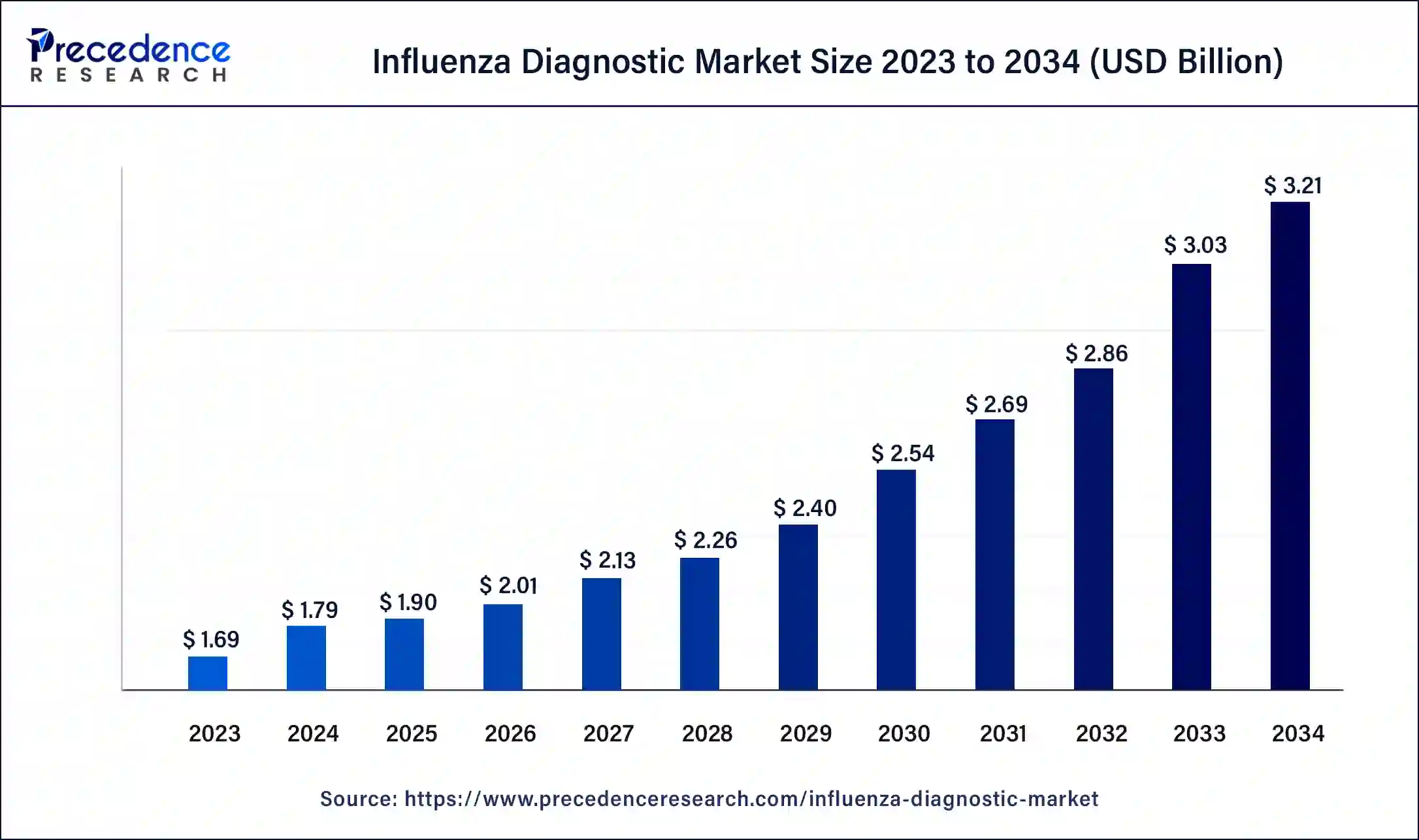The global influenza diagnostic market size reached USD 1.69 billion in 2023 and is predicted to hit around USD 2.97 billion by 2033, growing at a CAGR of 5.80% from 2024 to 2033.
Key Points
- North America dominated the market with the highest market share of 34% in 2023.
- Asia Pacific is observed to be the fastest-growing region in the market during the forecast period.
- By test type, the RIDT segment has contributed the largest share of 31% in 2023.
- By end-use, the hospitals segment dominated the market with the major market share of 48% in 2023.

The influenza diagnostic market is a dynamic sector within the broader healthcare industry, dedicated to the detection and diagnosis of influenza viruses. Influenza, commonly known as the flu, is a highly contagious respiratory illness caused by influenza viruses. It poses significant public health challenges globally, leading to considerable morbidity, mortality, and economic burden. The market for influenza diagnostics encompasses various testing methods, including rapid antigen tests, molecular diagnostics, viral culture, and serology. Accurate and timely diagnosis is crucial for effective management, surveillance, and prevention of influenza outbreaks.
Get a Sample: https://www.precedenceresearch.com/sample/3965
Growth Factors:
Several factors contribute to the growth of the influenza diagnostic market. Firstly, the recurrent nature of influenza outbreaks, coupled with the potential for seasonal epidemics and occasional pandemics, drives the demand for diagnostic tests. Additionally, advancements in diagnostic technologies, such as the development of rapid molecular assays and point-of-care testing devices, enhance the accuracy and accessibility of influenza diagnosis, thereby fueling market growth. Moreover, increasing awareness among healthcare providers and the general population about the importance of early detection and prompt treatment of influenza further stimulates market expansion.
Region Insights:
The influenza diagnostic market exhibits variations across different regions due to disparities in healthcare infrastructure, prevalence of influenza strains, regulatory frameworks, and economic factors. Developed regions such as North America and Europe typically have well-established diagnostic infrastructure and higher adoption rates of advanced testing modalities. In contrast, emerging economies in Asia-Pacific and Latin America may experience rapid market growth driven by increasing healthcare expenditure, rising awareness about infectious diseases, and improving access to healthcare services.
Influenza Diagnostic Market Dynamics
Drivers:
Several drivers propel the growth of the influenza diagnostic market. The foremost driver is the continuous evolution of influenza viruses, necessitating the development of innovative diagnostic solutions capable of detecting new strains with high sensitivity and specificity. Additionally, the growing geriatric population, who are more susceptible to severe complications from influenza, contributes to increased demand for diagnostic testing. Furthermore, government initiatives aimed at strengthening influenza surveillance programs and pandemic preparedness initiatives drive market growth by encouraging early detection and containment of outbreaks.
Opportunities:
The influenza diagnostic market presents numerous opportunities for market players to capitalize on emerging trends and technological advancements. Expansion into untapped markets, particularly in developing regions with high influenza burden, offers significant growth potential. Furthermore, strategic collaborations and partnerships between diagnostic companies, healthcare providers, and research institutions can facilitate the development of novel diagnostic platforms and enhance market penetration. Moreover, the integration of artificial intelligence (AI) and machine learning algorithms into diagnostic algorithms holds promise for improving the accuracy and efficiency of influenza diagnosis.
Challenges:
Despite the promising growth prospects, the influenza diagnostic market faces several challenges. One major challenge is the variability of influenza viruses and their ability to mutate rapidly, which poses difficulties in developing diagnostic tests with broad coverage against multiple strains. Regulatory hurdles, including the need for rigorous validation and approval processes for new diagnostic technologies, can delay market entry and increase development costs. Moreover, competition from alternative testing methods and the presence of counterfeit or substandard diagnostic products pose challenges to market players in maintaining product quality and market share.
Recent Developments
- In May 2023, Hologic Inc. declared that the Panther Fusion assay had received 510(k) clearance from the U.S. Food and Drug Administration (FDA). This assay is a molecular diagnostic test that can identify and distinguish between four common respiratory viruses that can present with similar clinical symptoms: influenza A (flu A), influenza B (flu B), severe acute respiratory syndrome coronavirus 2 (SARS-CoV-2) and respiratory syncytial virus (RSV).
- In January 2023, the healthcare goods and solutions firm 2San released a dual kit for SARS-CoV-2 and Influenza A+B. The OTC kit was introduced to ease the strain on healthcare facilities due to the continued demand on the National Health Service (NHS) following the epidemic.
Influenza Diagnostic Market Companies
- 3M Company
- Abbott Laboratories
- Becton, Dickinson and Company (BD)
- Meridian Bioscience, Inc.
- Quidel Corporation
- SEKISUI Diagnostics
- Thermo Fisher Scientific, Inc.
- Hologic, Inc.
- F. Hoffmann-La Roche Ltd
- SA Scientific Ltd
Segments Covered in the Report
By Test Type
- RIDT
- RT-PCR
- Cell Culture
- Others
By End-use
- Hospitals
- POCT
- Laboratories
By Geography
- North America
- Europe
- Asia-Pacific
- Latin America
- Middle East and Africa
Contact Us:
Mr. Alex
Sales Manager
Call: +1 9197 992 333
Email: sales@precedenceresearch.com
Web: https://www.precedenceresearch.com
Blog: https://www.expresswebwire.com/
Blog: https://www.uswebwire.com/


0 Comments